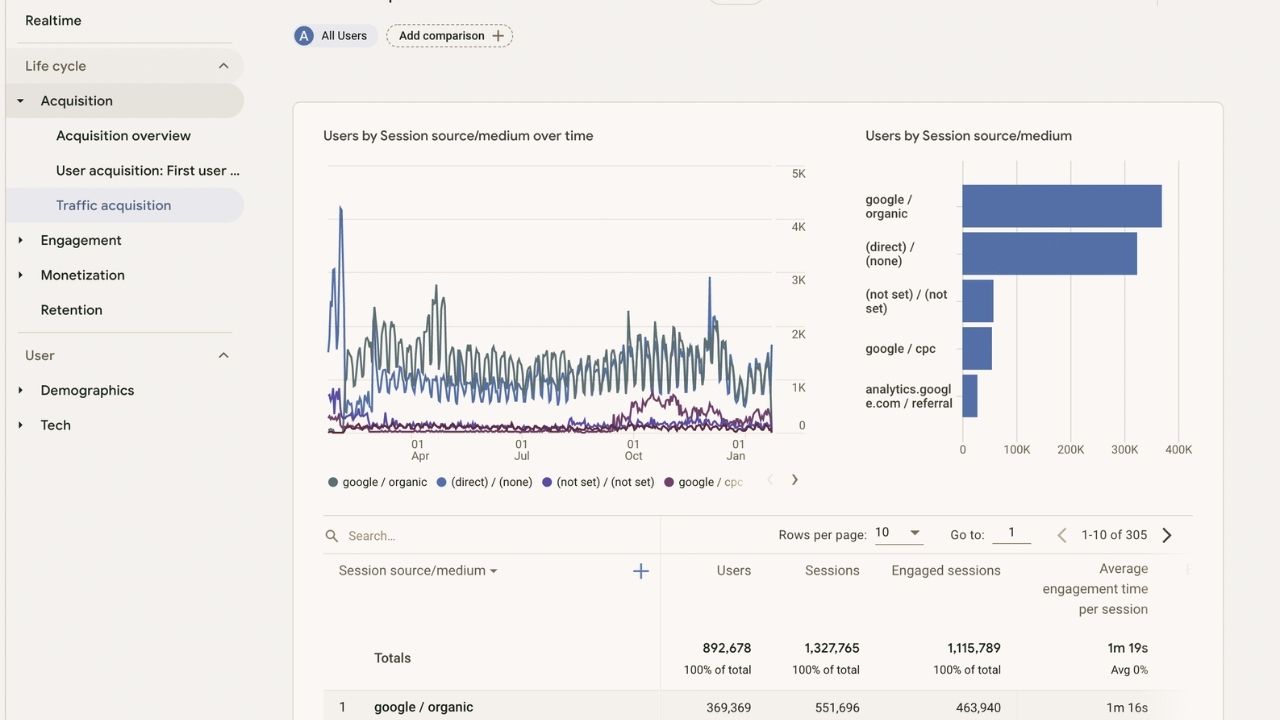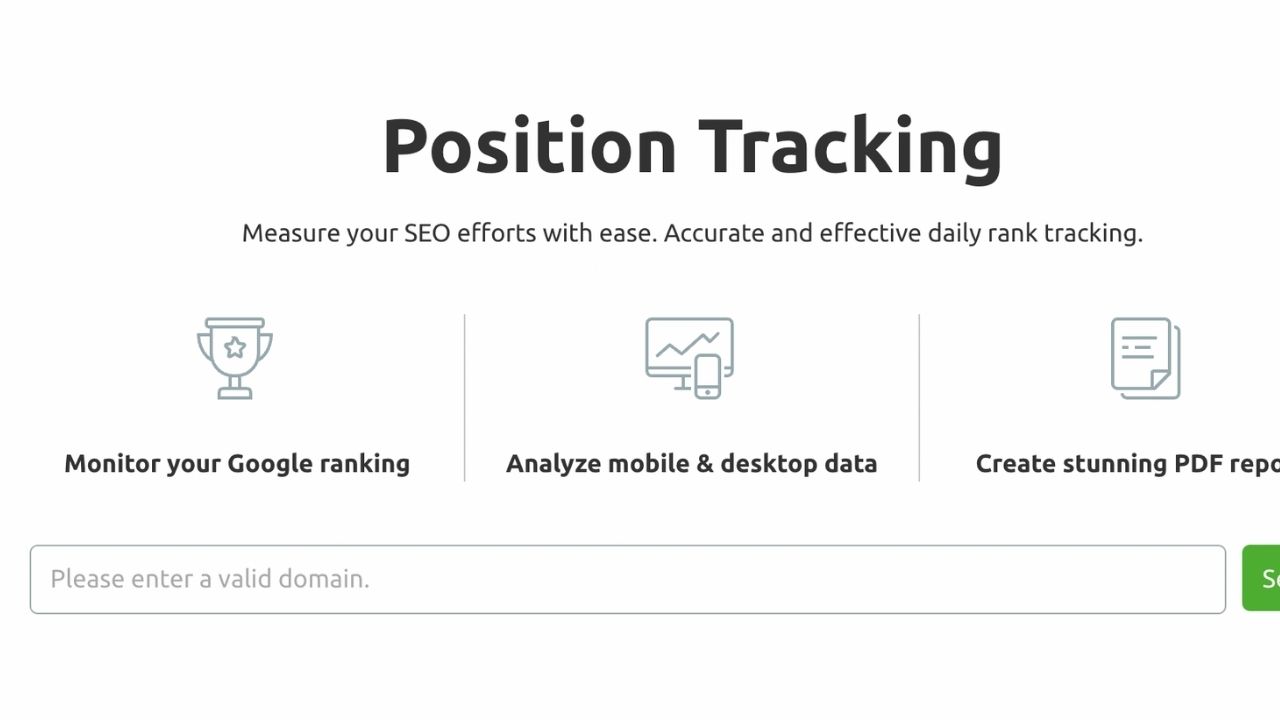The Top 4 KPIs for SEO You Really Need to Track (And Where To Find Them).
Jan 25, 2022
So, you’ve been putting a whole lot of hard work into optimising your website and your content, but how can you tell if all that blood, sweat and tears is actually paying off?
Well, you need to get your head around the top 4 KPIs for SEO and start tracking them!
Today I’m going to talk you through the most important Key Performance Indicators (KPIs) you can use to track your SEO performance, and they are:
But before we jump into looking at the best KPIs for showing your SEO progress, let’s take a step back a minute and look at what makes a top KPI in the first place.
So, what’s a top KPI anyway?
The answer to that question is one of those really annoying, “it depends” kind!
But seeing as you’re running your own online business, and you’re not (yet!) dealing with the complexities of running a vast multinational, I’m going to stick my neck out and say that if you make sure your SEO KPIs cover the 4 things I’m going to set out next for you, you’ll be well on your way to creating some top metrics for your business.
1. Make sure your KPIs are measurable.
As good old Peter Drucker supposedly said, “ if you can’t measure it, you can’t manage it.”
Try and make sure there is actually a way you can track the measures you want to keep tabs on, and remember, the way you make things measurable is by getting specific.
So, don’t make a KPI “grow my business”; instead, go for something like “increase my income from coaching clients by 50% in 2022.
Or increase the number of coaching clients I onboard and retain for 6 months by 10 people in 2022.
Some easily measurable KPIs for tracking your SEO performance include organic traffic growth, keyword rankings, increased domain authority, growing quality backlinks, and better conversion rates.
2. Make sure your KPIs are aligned with your business goals.
A top KPI needs to be aligned to your business and your business only.
If you’re running a health coaching business and working one-on-one with clients, you might not want to attract more and more clients, as you’re limited by the hours in the day.
Be careful to look at KPIs that are important to you and your business. There are loads of metrics that will give you new customer acquisition stats, but are they what you’re really looking for?
Maybe you’d be better off looking at customer retention?
3. Can you actually action changes? Are your KPIs actionable?
So, if you’re working from the premise that you’re measuring your KPIs with the intention of making any changes you need to improve your performance, you need to make sure you’re in a position to do just that.
So, don’t measure something you have no control over or that you can’t fix!
Also, make sure your KPIs measure achievable things and don’t overwhelm you.
4. Are your KPIs simple?
Lastly, make sure you keep your KPIs simple.
Try not to set metrics that open up even more questions than they answer, and also make sure they’re simple to track.
Try something like “the number of new clients this quarter” or the “number of new leads” and build up from there once you need more detail.
The 4 Best KPIs for SEO.
So now you know what a top KPI is, how do you start setting KPIs to track your SEO performance?
I’ve got 4 SEO KPIs for you that will do just that, and which you can make sure are relevant to your own business with just a few tweaks.
Oh, and of course, I’m also going to show you where you can find the data, so you can actually start tracking them!
1. Organic Traffic.
Organic traffic is the number of visitors that have come to your site via organic search.
Organic searches are results that show up on the SERPs which are not paid for.
It’s your SEO efforts that primarily drive organic traffic.
Getting your keywords working for you, making sure your website is optimised and creating consistent, well-optimised content will, in time, drive your organic traffic up.
So, if your organic traffic is increasing, your SEO is working.
So how do you track your organic traffic?
This is a straightforward metric to track if you’ve set yourself up on Google Analytics.
Read the blog I wrote for you if you need any help getting set up on Google Analytics.
So, the first step is to hop over to Google Analytics.
On the dashboard, click on Acquisition - Traffic Acquisition - and look at Organic Traffic.
You’ll find a graph that sets out the traffic source of all your website users for the last 28 days.

alt="Headings and SEO"
If you want to change that timeframe, just click on the drop-down box at the top right of the page and choose the time frame you want.
Expanding the time frame can be helpful if you want to see the impact of your SEO work over time.
It’s also helpful to track the organic traffic to specific sections of your site, like your blog or landing pages.
As an SEO KPI, you’re looking for your organic traffic to be increasing over time.
2. Keyword Ranking.
There are lots of different rankings you can measure for your website, but the most helpful thing to measure from an SEO KPI perspective is the performance of your keywords.
The better your keywords perform for you, i.e., the higher your ranking for a specific one, the better your business results.
So, you want to see which of your keywords are performing best for you.
How to track your keyword rankings.
There are lots of great, free keyword tracking tools. Here’s a list of some I’d recommend.

Once you’ve found the one you like, stick with it, as each measures performance differently, and you’ll drive yourself mad trying to compare apples with oranges!
3. Customer Engagement.
This one is a bit more tricky, but only because you have to define what you mean by customer engagement first.
So what are you going to look at?
Once someone is on your site, what are you interested in them doing?
Do you want them to read some content?
Or perhaps there’s something you want them to do, like click on a form?
Or maybe you want them to make a purchase, so looking at who has entered your sales funnel and how far they’ve progressed will be really important to you.
So, while your customer engagement metrics might be very different from someone else’s, they are hugely important for tracking the success of your SEO as your engagement figures show you how well your content is working for you and how good the user experience is on your website.
How to track Customer Engagement.
It’s time to go back to Google Analytics and look for “Engagement” on the left-hand side of your dashboard.
Now I’m talking about GA4, not UA, and Engagement is a new metric. It shows how your visitors engage with your website, rather than just showing how quickly they leave.
To have an engaged session, a visitor has to take one or more of these actions:
- Engage actively with your website for more than 10 seconds.
- Make two or more screen or page views.
- Fire a conversion event, which you can set up, and include things like making a purchase, subscribing to your lead magnet, entering your checkout etc.
Engagement rate is super helpful in understanding how people are using your site and what experience they’re having.
You can also see which SEO strategies are working well for you. If you’re getting lots of traffic from a specific tactic or a blog, and you see a good engagement rate, you know you can carry on with your plan or create more of the same kind of content or even a product.
On the flip side, if you’re getting lots of traffic, but not much engagement, then you know you need to tweak your SEO on your website or optimise the content you’re directing them to.
4. Conversions (Sales and Leads).
Of course, making money doing the work you love is at the top of your agenda, and you want to see that you’re being rewarded for all your efforts.
So, yes, you need to track your sales, and it’s super important from an SEO perspective too.
All that organic traffic you’ve been driving to your site has been coming from your keywords (and, yes, some other important SEO factors), and you want to make sure you’ve chosen the right ones.
While you might be attracting traffic to your website, you want to make sure your SEO strategy brings the right kind of visitors to your site, so your conversion rate is hugely important.
It’s important to say here that conversion in terms of leads into sales isn’t the only important metric to look at here.
Moving quality traffic through your sales funnel can take time, and there are lots of other conversion events that you might want to look at.
Just to be clear, a conversion event is when a visitor to your website completes an action that you want them to take, like filling out a form or making a purchase.
The percentage of total visitors that convert is called your conversion rate. You can have conversion rates for online sales, leads, email list opt-ins, form completions…you name, and it’s important to your business you can track it as a conversion.
And in terms of SEO, you can see how well your strategy is working by looking at how well your traffic is converting.
If you’re getting lots of traffic and seeing lots of the right conversion events - great news - your SEO is working, and you’re attracting the right kind of people to your website.
If you’re getting lots of traffic, but you’re not converting it into sales, then it’s likely you’re not optimising your website and content for the right keywords.
How to track your Conversions.
Yup, you guessed it, head on back over to Google Analytics.
In the Engagement section, look at the Conversions section.
Once you’re here, you’ll be able to see the conversions you’ve defined for your business and how you’re performing on them over time.
If you head over to the Monetization section, you can track your sales conversions by looking at “e-commerce purchases.”
You’ll also find all sorts of other sales data like how many people looked at your products, how many people added it to their cart, and what sales revenue you’ve made.
What KPIs are you going to track?
So there you have it, the four top KPIs for SEO.
Each of these simple metrics will help you track your SEO performance - and of course, your business performance at the same time.
It’s so important to have a proper grip on your business, so set out what KPIs you’re going to track and once a month or every week, if you’re keen, hop over to Google analytics and see what progress you’re making.
If you see improvements, excellent, well done.
If things are going backwards, drop me a line, and I’ll see if I can help!
Contact Sarah
Click here to leave me a message. I'll get back to you as soon as I can. thank you.
We hate SPAM. We will never sell your information, for any reason.

